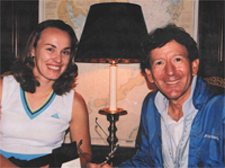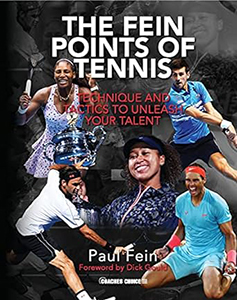Pat Cash on the Volley
Part 3
Interviewed by Paul Fein 2017
On the high backhand volley, should the racket end up at the same height where the ball is contacted?
First, let's describe the height zones. The high zone is above the shoulders. The medium zone is from the waist to the shoulders. And the low zone is below the waist. The volley followthrough is the same as groundstrokes in some respects. The highest volley, of course, is the smash, and like the serve, its follow-through is sharply downwards.
The opposite is true for the very low volley, though it's not a drastically sharp upwards movement because that will create a pop-up volley. But for most volleys between the chest and the waist, a reasonably level or parallel followthrough with some rotation of the shoulders and arm is good.
Which variables determine grip firmness for the volley? The strength of the player? The speed and spin of the oncoming ball? Or the intended shot of the volleyer?
The grip firmness at contact must be strong. Otherwise, the wrist will bend and that will produce a loss of control in the racket. We see this problem a lot with children who lack strength. A player's arm should be relaxed most of the time until just before contact when the grip will be squeezed harder. This takes a lot of strength and endurance, and it takes many years to develop a strong wrist and forearm.

Look at old photos of players who use heavy wooden rackets to see how much their forearm is developed. Players such as Rod Laver and Guillermo Vilas were famous for their enormous forearms. Laver's left forearm was two and a half inches bigger than his right forearm and even bigger than the forearm of heavyweight boxing champion Rocky Marciano.
Even today's players who volley infrequently and use lighter rackets, often their two arms still have contrasting size and strength. Federer often jokes that his left arm is purely ornamental.
How firm should the grip be for the drop volley?
The only real exception is the drop volley off a firmly hit ball. With practice, most players can learn this difficult shot by softening their grip, slightly breaking their wrist, and beveling the racket face to create backspin. With this shot, no backswing or follow through is required, and the oncoming ball must be allowed to force the racket backward absorbing some shock.
The speed of the ball will quickly decrease, enabling it to barely rebound off the racket and then drop short in your opponent's court. Keep in mind that the drop volley is an advanced shot requiring a honed skill and a lot of athletic ability.
In his instruction book, Tennis 2000, distinguished teaching pro Vic Braden wrote: “The reason pros can volley so well is that they start moving as or before the ball is hit, whereas the average player waits until the ball reaches the net." Would you please elaborate.
This is correct in many ways because the pros have excellent anticipation. The best volleyers in the world are always moving, constantly shuffling their feet backward and forward, left and right, preparing for a passing shot or a lob. As Isaac Newton said, a body in motion tends to stay in motion.
For me, the toughest workouts in tennis are at the net when your legs are burning and your forearm is aching. The aim is to always get quickly into the correct position where your knees are bent and you are able to bound in and out of position. I see very little point in a high-energy volley workout if you're not starting just behind the service line and moving forward.
My most beneficial workout, and one that has become famous in tennis academies around the world, is when I start from one step inside the baseline moving forward as fast as I possibly can while my coach, or the other player, feeds ball anywhere in the court. My challenge is to get to that ball and stay in the rally as long as I can. I have done this for thousands of hours over my career.
When should you split step? And why is the split step so important at the net?
Split step when your opponent contacts the ball. By slowing down your forward movement toward the net, you are able to position your legs so that a diagonally left or right movement is possible. If you don't slow down and split step, changing direction sharply is nearly impossible even for someone with thighs as strong as mine were. The secret to the split step is not to jump too wide or too high or slow down too much.
In time, with plenty of practice and fitness work, you can run 90−100% of your maximum speed forward, split step, and turn without losing your balance. But if the ball drops short, you can just continue your quick movement forward. All but a couple of players on the circuit now, in my opinion, move too slowly to the net. Before the 2015 Wimbledon, I worked with Marcos Baghdatis, and we improved his results at the net significantly just by focusing on his movement.
Who moves quickly enough?
Edberg, McEnroe, and Kriek were some of the quickest at the net I played against. Federer and Nadal move very quickly now. For the women, Navratilova, Graf, and Henin. Before them, Billie Jean King, Margaret Court, and Evonne Goolagong Cawley. I remember watching them when I was a junior, and my coach pointed out their great movement.

Are crossover steps and diagonal movement the best ways to reach wide volleys?
Another great fallacy about volleys is that you have to use crossover steps for every volley. Much like for groundstrokes, how much time the volleyer has to react dictates the leg movement, especially when the ball is within arm's length. There is no reason to use a crossover step when an oncoming ball is hit within arm's length, such as when the returner hits the ball straight to you in doubles. Our aim is to position ourselves so that we have the strongest contact position.
Remember, we are aiming to hit the ball only slightly in front of us and slightly to our side, so why do we feel the need to lunge our legs across our body? Nothing more than a quick shuffle or half step to the side is required. I believe that up to 60% of volleys could be hit in an open or semi-open stance.
The crossover step volley was used almost exclusively during an era when the ball was not hit as fast and the players had a greater chance to cut off the low volley with a lunge. Just as important, they had a little more time then to get back into position. Rod Laver and Ken Rosewall often used an open stance when rushed. For me, the best movers around the net, and superior to most tennis players, are badminton players. They use a cross legged movement pattern only when they're stretched very wide.
When should you use crossover steps?
The two exceptions to the rule are if the ball is very wide or very short dropping over the net. Both situations require you to lunge after the ball, and the best way to stretch the farthest distance is to bring the opposite leg across the body. This movement is time-consuming. It's also time-consuming to move back to a neutral stance position ready for the next ball. This is why I like the open stance volley, which we see more in top-level doubles when the ball is moving at rapid speeds.





